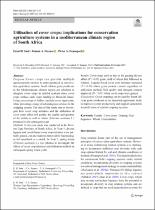| dc.contributor.author | Smit, E H | |
| dc.contributor.author | Strauss, J | |
| dc.contributor.author | Swanepoel, P A | |
| dc.date.accessioned | 2022-08-04T18:44:59Z | |
| dc.date.available | 2022-08-04T18:44:59Z | |
| dc.date.issued | 2021 | |
| dc.identifier.citation | Smit, Ernst & Strauss, Johann & Swanepoel, Pieter. (2021). Utilisation of cover crops: implications for conservation agriculture systems in a mediterranean climate region of South Africa. Plant and Soil. 462. 1-12. 10.1007/s11104-021-04864-6. | en_US |
| dc.identifier.issn | 0032-079X | |
| dc.identifier.issn | 1573-5036 | |
| dc.identifier.uri | 10.1007/s11104-021-04864-6 | |
| dc.identifier.uri | http://hdl.handle.net/10566/7690 | |
| dc.description.abstract | Purpose
Cover crops can provide multiple agroecosystem services to crops produced in conservation agriculture systems. South African grain producers in the Mediterranean climate region are reluctant to integrate cover crops in rainfed systems since cover crops replace cash crops leading to financial losses. Using cover crops as fodder can help cover input costs, while providing a range of advantageous services to the cropping system. The aim of this study was to investigate how cover crop mixtures and the utilisation of cover crops affect soil quality, the quality and quantity of the mulch as well as wheat (Triticum aestivum L.) produced in the subsequent year.
Methods
A two-year study was conducted in the Western Cape Province of South Africa. In Year 1, diverse legume and cereal-based cover crop mixtures were partially grazed, cut and material removed for haymaking, or left unutilised as a mulch. In Year 2, spring wheat (Triticum aestivum L.) was planted to investigate the effects of cover crop mixtures and utilisation method on subsequent spring wheat yield.
Results
Cover crops used as hay or for grazing did not affect (P < 0.05) grain yield of wheat that followed in rotation. Legume-based cover crop mixtures increased (P < 0.05) wheat grain protein content regardless of utilisation method. Soil quality and nitrogen content improved (P < 0.05) when cover crops were grazed.
Conclusions
Cover cropping can be used by South African grain producers as an important agronomic tactic to improve system productivity and support sustainable intensification of rainfed cropping systems. | en_US |
| dc.language.iso | en | en_US |
| dc.publisher | Springer | en_US |
| dc.subject | Cereals | en_US |
| dc.subject | Cover crops | en_US |
| dc.subject | Grazing | en_US |
| dc.subject | Legumes | en_US |
| dc.subject | Crop rotation | en_US |
| dc.title | Utilisation of cover crops: implications for conservation agriculture systems in a mediterranean climate region of South Africa | en_US |
| dc.type | Article | en_US |

